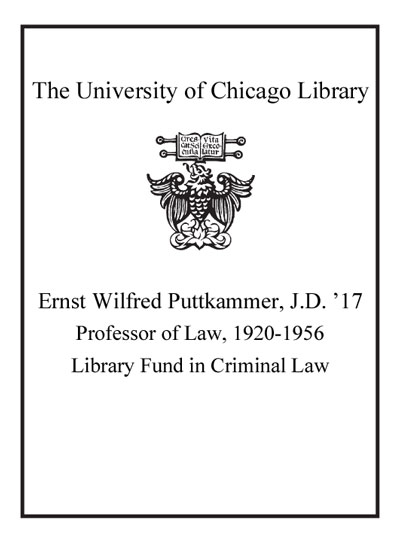Just sentencing : principles and procedures for a workable system /
Saved in:
| Author / Creator: | Frase, Richard S. |
|---|---|
| Imprint: | New York : Oxford University Press, c2013. |
| Description: | xv, 280 p. ; 24 cm. |
| Language: | English |
| Series: | Studies in penal theory and philosophy Studies in penal theory and philosophy. |
| Subject: | |
| Format: | Print Book |
| URL for this record: | http://pi.lib.uchicago.edu/1001/cat/bib/8953530 |
Table of Contents:
- Preface
- Introduction
- A. Sentencing at the Crossroads: Recent Major Changes in Goals, Procedures, Law, and Practice
- B. The Need for a Model That Accommodates All Major Sentencing Purposes and Limitations
- 1. Overview of Sentencing Principles
- 2. Conflicts within and across Punishment Principles
- C. The Current Limiting-Retributive Model
- D. Other Hybrid Punishment Theories
- E. The Expanded Limiting-Retributive, State-Guidelines Model (the "Expanded Model")
- 1. Sentencing Principles
- 2. Sentencing Procedures
- F. Organization of Chapters
- 1. The Expanded Limiting-Retributive, State-Guidelines Model
- A. The Expanded Model's Sentencing Principles
- 1. Definite but Asymmetric Desert Limits
- 2. Recognition of Expressive Goals, Symbolic Censure, and Conditional Hard Treatment
- 3. Recognition of the Ends-Benefits Proportionality Principle along with Parsimony
- 4. Social Equality as a Further Limiting Principle
- 5. Within-Desert Adjustments Based on Offender Risk and Needs but Not on Deterrence
- 6. Retention of Substantial Sentencing Discretion and Control by Judges
- 7. Front-End, System-Wide Management of Correctional Resources
- B. The Expanded Model's Sentencing Procedures
- 1. State Sentencing Guidelines as the Structural Model
- 2. A Permanent, Independent, and Adequately Funded Sentencing Commission
- 3. Required Resource- and Demographic-Impact Assessments
- 4. Legally Binding Guidelines Enforced by Active but Not Overly Intrusive Appellate Review
- 5. Required Statements of Reasons for Departures and Some Nondepartures
- 6. Moderate Limits on Judicial Discretion, with No Mandatory Penalties
- 7. Limited Sentence Enhancements for Prior Convictions and Multiple Current Offenses
- 8. Starting Points: Middle of Recommended Custody Range; Zero for Probation Conditions
- 9. Frequent Use of Suspended-Execution Sentences
- 10. Encouraged Intermediate Sanctions with Maximum but No Minimum Severity Limits
- 11. Consideration of Proportionality, Parsimony, Social Equality, and Offender Risks/Needs
- S. ummary: How Judges Would Apply the Model
- 12. Limits on Sentence Modifications via Revocation or Changed Conditions of Release
- 13. Abolition of Parole-Release Discretion, with Supervised Release Unrelated to Good Time
- 14. Inmate Good-Conduct Credits Moderate in Amount, but Reflecting Program Participation
- 15. Additional Desirable but Not Essential Procedures
- C. Conclusion
- 2. Limiting Retributivism and Other Hybrid Theories
- A. Norval Morris's Hybrid Model
- B. Hybrid Theories Proposed by Other Writers
- 1. The "Separate Questions" Approach of H. L. A. Hart and Others
- 2. A Sampling of Other Relatively Undeveloped Hybrid Theories
- 3. Paul Robinson's Hybrid Model
- 4. Andrew von Hirsch's More Complete Hybrid Model
- 5. Critiques of Hybrid Theory, and Counterarguments to the Critiques
- C. Conclusion
- 3. Elements of the Expanded Model in Minnesota, Other Sentencing Systems, and Model Codes
- A. Minnesota's Guidelines-Based Limiting-Retributive System
- 1. Overview of the Minnesota Guidelines
- 2. Features of the Expanded Model Found in Minnesota Sentencing Theory and Practice
- 3. Important Features of the Expanded Model Not Yet Adopted in Minnesota
- 4. Additional, Desirable Procedures Not Yet Adopted in Minnesota
- B. Other Well-Developed State Guidelines Systems
- 1. Washington
- 2. Oregon
- 3. Kansas
- 4. North Carolina
- C. Features of the Expanded Model in Other Guidelines Systems
- D. Limiting-Retributive and Other Expanded Model Elements in Nonguidelines Systems
- 1. American Statutory Determinate Sentencing Systems
- 2. American Indeterminate Sentencing Systems
- 3. Sentencing in Other Western Nations
- E. Features of the Expanded Model in Recommended Sentencing Standards and Codes
- 1. The Original and Revised Model Penal Code
- 2. The American Bar Association Sentencing Standards
- 3. Other Recommended Standards and Goals
- F. Conclusion
- 4. The Problem of Enhancements for Prior or Multiple Current Convictions
- A. Prior-Record Enhancements
- 1. Retributive Arguments for (and against) Prior-Record Enhancement or Mitigation
- 2. Utilitarian Arguments for (and Against) Prior-Record Enhancements
- 3. The Expanded Model's Treatment of Prior-Record Enhancements
- B. Sentencing of Multiple Current Offenses
- 1. Varieties of Multiple-Current-Offense Sentencing
- 2. Sentencing Purposes and Principles
- 3. The Expanded Model's Handling of Multiple Current Offenses
- C. Conclusion
- 5. The Problem of Disproportionate Racial Impact
- A. Extent and Causes of Disproportionate Minority Confinement
- 1. The Magnitude of Disproportionate Confinement
- 2. The Causes of Disproportionate Minority Confinement
- B. How Crime and Criminal Justice Cause More Crime and Perpetuate Social Disadvantage
- C. What to Do?
- 1. Social Equality as a Further Limiting Principle
- 2. A Workable Systemic-Level Solution: Racial-Ethnic Impact Assessments
- 3. Feasible Changes in Disparity-Increasing Sentencing Laws, Guidelines, and Practices
- D. Conclusion
- Conclusion
- References
- Table of Cases
- Index

